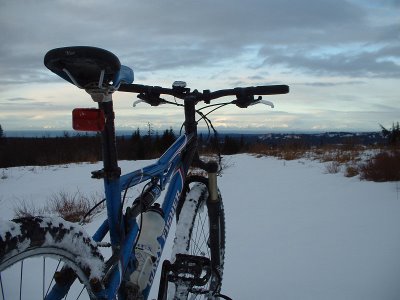 Date:
Date: Jan. 8
Mileage: 21.2
January mileage: 129.4
Temperature upon departure: 33
At the risk of embarrassing myself terribly with my lack of gear-related knowledge, I'm compiling a list of my current winter riding and Susitna 100 gear, all in hopes that suggestions, recommendations and maybe even some direction to good used stuff will come my way.
My bike: I ride a Gary Fisher Sugar 3 with women's specific geometry. Componentry is all stock stuff. I originally bought this bike with Grand Teton rock trails and the southern Utah desert in mind. Since I moved to Alaska, it's converted nicely to a winter bike, as I suspect any mountain bike would. It would be nice to find a rigid bike, or, if the heavens opened wide, an affordable Surly Pugsley. But for my first year of winter riding, this works fine.
My tires: Ok. I admit it. I went to the bike shop and bought the pair of Kenda studded tires that were on sale. If I could go back in time and purchase the Nokian Extremes, I'd do it (my knees, after taking the brunt of a good spill on today's icier stretch, would probably thank me.)
Footgear: Around here, I usually ride with a couple of pairs of socks and my hiking shoes. On the Susitna 100, I plan to wear: a liner sock, neoprene sock, big smart wool sock, lightweight winter boots, neoprene booties, and - depending on conditions - gaters.
Gloves: I usually go really light on gloves when I ride around here - unless temperatures are below 30, nothing more than my synthetic glove liners. During the race, I'll use those or neoprene liners with my new CZIP gloves and possibly, if the heavens open wide, bike pogies.
Head and face: I have a neoprene face mask, a thin synthetic head warmer, a polar fleece balaclava and goggles. Around town, even when temperatures have been near zero, I've gotten by with only the thin head warmer.
Legs: Around town I always wear fleece or nylon pants, or my snowboarding pants if it's precipitating. I need to figure out some good layering techniques for the Susitna 100. This is one area I'm awaiting recommendations.
Torso: I'll probably bulk up on the fleece and synthetic layers, and cover everything with a waterproof shell. Race organizers tell us to plan on a temperature swing of 40 to 50 degrees during the race, with possible temperatures that can range anywhere from -40 to +40 degrees. The torso layers are the ones that will fluctuate the most based on race conditions.
Stuff I'll be lugging on my bike rack: I'm still mulling the possibility of using small panniers, or just stuffing everything in a dry bag and strapping that to the rack. Carrying technique is something I haven't decided, but I do know what I need to carry.
What I have: bivy sack, assorted tools, tube changing kit, spare tubes, knife, small cooking pot (to melt snow if needed), and spare clothing.
What I still need to purchase: sleeping bag rated to at least -20, insulated sleeping pad, liquid fuel stove, map and 5,000-7,000 calories worth of food (I know. It's tempting to just carry a jar of peanut butter).
Water system: Camelbaks have great insulation against freezing, especially if I get a hose insulator, and I already have experience cycling long distances with one of those on my back. So that will probably be the way I'll go.
Miscellaneous: Really, if I'm forgetting anything that might keep me alive and/or comfortable, please feel free to drop in a cautionary comment. I'll probably carry Duct Tape, because I'm an Alaskan now. I have a Cateye 5 LED headlight as well as a focused LED headlamp, and I'll need to get spare lithium batteries for both of those. I need to purchase a reliable firestarter (no Bic lighters for me) and some matches. Plus ibuprofen ... and maybe some NoDoz (I know from experience ... I can go far on the wonders of caffeine.)
There's probably several crucial things I'm forgetting. As far as the actual race, my plan is still to just go out, try my best, and prepare for the worst. Trail conditions can swing this thing open wide, and there's really no way to anticipate exactly what I'm facing. The first woman cyclist to finish in 2004 crossed the finish line after 20 hours and 30 minutes. The roster's up now for 2006,
my competition. My goals for the Susitna 100 are, in order of hierarchy:
1. Survive.
2. Survive with all of my digits intact.
3. Finish the race.
4. Finish the race in less than 24 hours.
All the rest is breathing and pedaling. I think it's going to be a lot of fun.
 Date: Jan. 10
Date: Jan. 10






